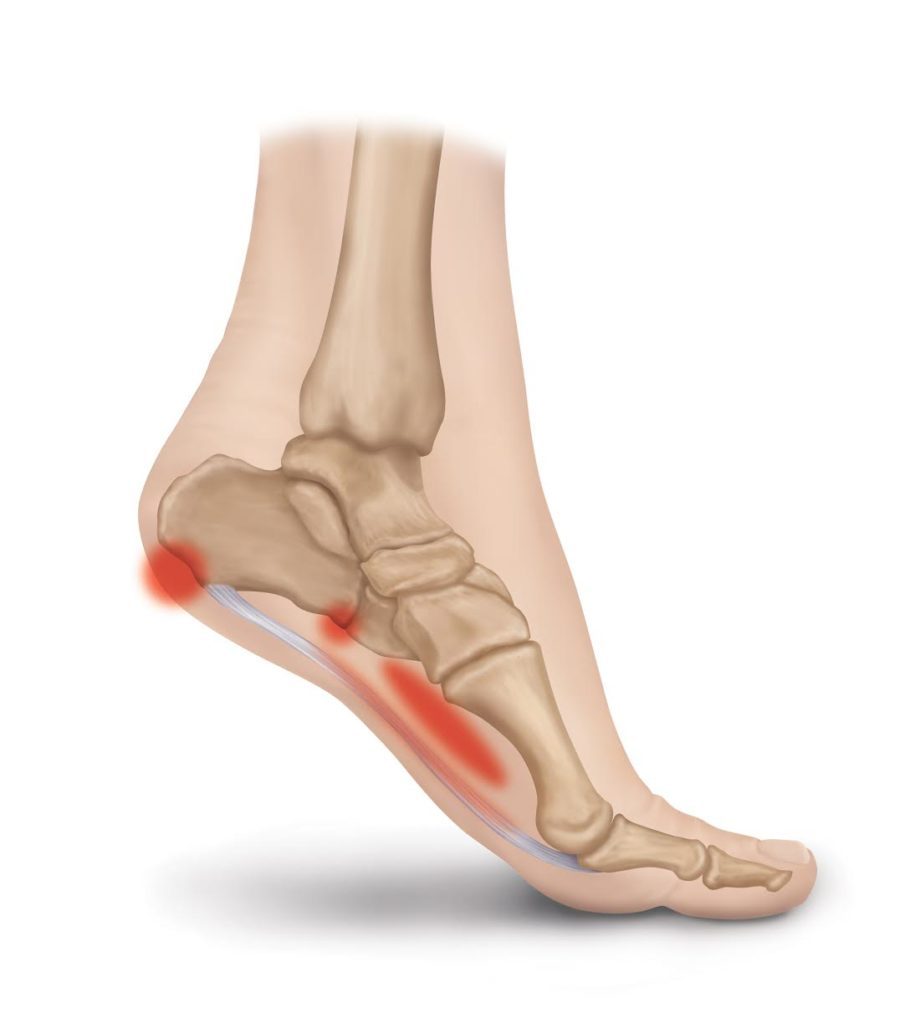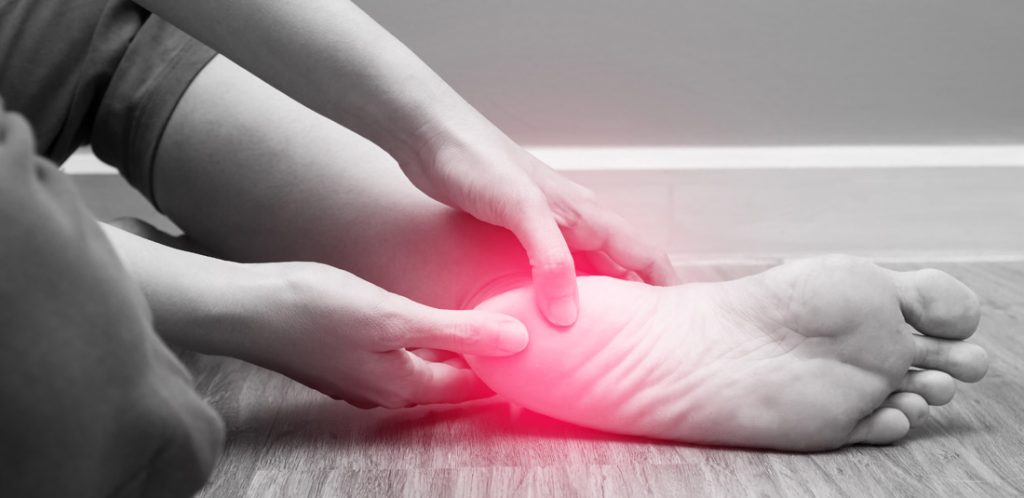Plantar fasciitis is the largest cause of heel pain that we treat.

Plantar fasciitis describes an injury to a tissue called the plantar fascia at the bottom of your heel and foot. When the fascia is overloaded with pressure, is strained or is directly damaged, it becomes inflamed and tender.
Your plantar fascia is a thick connective tissue band that originates from your heel and then spans your foot like a fan to connect to all five toes. You have connective tissues all around your body that work to connect, stabilise and enclose musculature and structures throughout the human body. Then plantar fascia helps to facilitate the function of the foot and maintain its shape, strength and flexibility.
Not plantar fasciitis? While this is the most common cause of heel pain, other conditions like heel bursitis, stress fracture, growing pains in kids, Achilles problems, fat pad injury and other problems can also cause heel pain. During your first visit, you’ll receive a comprehensive assessment to confirm your diagnosis, and your condition will be explained.
What causes plantar fasciitis?
Plantar fasciitis is caused by overloading, overusing and straining the fascia past the point that it can handle so that micro-tears occur in the fibres of the tissue. This may be caused by:
- A sudden increase in physical activity or the intensity of activity
- Particular activities that strain the arch such as climbing stairs
- Wearing shoes that don’t support the arch and fascia – especially if you’re used to wearing supportive footwear regularly
- Your foot type or foot biomechanics that put a greater load or force through the fascia (like having a pronated, flatter foot that may cause the fascia to be overused at critical moments during gait)
- Damage to the insertion of the fascia at the heel, such as jumping down from a high surface
- Faulty training technique
- Increased body weight
- Increasing age
During resting or non-weight-bearing periods, the plantar fascia shortens. When body weight is rapidly applied to the foot the fascia must stretch and quickly lengthen, causing micro-tears in the fascia. Hypermobility, (excessive internal motion) of the foot can induce future or coexisting problems involving the knee, hip, sacroiliac joint or the low back region.
Often, it is a combination of multiple causes that have ultimately overloaded the fascia. These causes must be corrected to prevent plantar fasciitis from being an ongoing problem for you in the future.
 Symptoms
Symptoms
The most common symptom of plantar fasciitis is heel pain first thing in the morning which tends to ease after a few minutes of walking. Other symptoms include:
- Pain at the bottom of the heel that may radiate into the arch
- Swelling
- Pain on standing after rest
- Pain may come and go, or be constantly present. Often pain can ease a few minutes after you start walking around
- Pain can range from mild discomfort to an intense stabbing pain
Symptoms can come and go over months or even years, without the problem being completely resolved. Because the damage to the fascia can worsen to a partial tear if left untreated, it’s important to see your Podiatrist to start your recovery.
Care must also be taken as the symptoms of other conditions may also closely match the symptoms of plantar fasciitis. A good example of this is Abductor Hallucis Tendinopathy, where the Abductor Hallucis muscle shares an insertion at the base of the heel with the plantar fascia.
Heel Spurs
After many years, a heel spur may develop on the bottom of the heel (calcaneus) in addition to plantar fasciitis. Having a heel spur, however, does not mean that you have or will develop heel pain.
Heel spurs are visible on a lateral view x-ray of the foot. X-rays sometimes reveal very large heel spurs in patients that have never experienced any heel pain. It is not this bony spur, but rather the inflammation of the fascia that is attaching to the heel which causes discomfort. This is a common misconception. To learn more about heel spurs, see here.
How is plantar fasciitis treated?
Once we understand exactly what has caused your plantar fasciitis, we will create a comprehensive treatment plan for you that takes into consideration your daily activities, lifestyle and goals.
Initially, the focus of the treatment plan will be to reduce your current symptoms and get you out of pain, while long-term your treatment plan will work to prevent this from happening again. Once you’ve had plantar fasciitis, you’re more likely to damage your fascia again, so future prevention is important. Depending on the severity of your symptoms, your treatment may include:
- Custom orthotics – these will support the arch and reduce strain and tension on the plantar fascia so it can begin to heal as opposed to being constantly stretched during walking
- Shockwave treatment – shockwave is a safe and effective treatment that is proven to accelerate your healing and recovery from heel pain. We’re proud to be the only clinic in the area to have this treatment available at present.
- Foot mobilisation – foot mobilisation uses hands-on manipulation to work on stiff and dysfunctional joints to best support your recovery
- Footwear review – your regular footwear will be checked and discussed to make sure it’s helping your recovery and not hindering you
- Strapping – to reduce painful symptoms by keeping your foot in a position that relieves strain and pressure from the plantar fascia
- Stretching – once the initial pain and inflammation settle and you are able to handle gentle stretching, stretching the fascia can help reduce and prevent the onset of painful symptoms. Because other tight muscles in the feet and legs can pull on the heel and therefore the fascia, stretching will also focus on other tight muscle groups too
- Strengthening – working to strengthen the muscles of the feet and legs can improve your overall foot and leg function, thereby reducing the risk of injury. Strengthening exercises will be prescribed on a case-by-case basis after reviewing the results of your assessment.
- Exercise review – we’ll make sure the exercise you’re currently doing won’t prolong your recovery or worsen your plantar fasciitis
- RICE – Rest, ice, compression and elevation may be initially used to reduce pain and swelling
- Anti-inflammatory medication – to temporarily relieve pain in the fascia
Will the pain come back?
Just like you can break your leg or sprain your ankle twice, you can definitely develop plantar fasciitis again. The key is to have the right preventative measures in place to reduce the risk of this happening again. By knowing about the condition and its causes, you can make the best decisions for your feet. Make sure you talk through any questions you have with us so you can understand how to best protect and look after your feet.
https://www.mastertonfootclinic.co.nz/heel-spurs/



